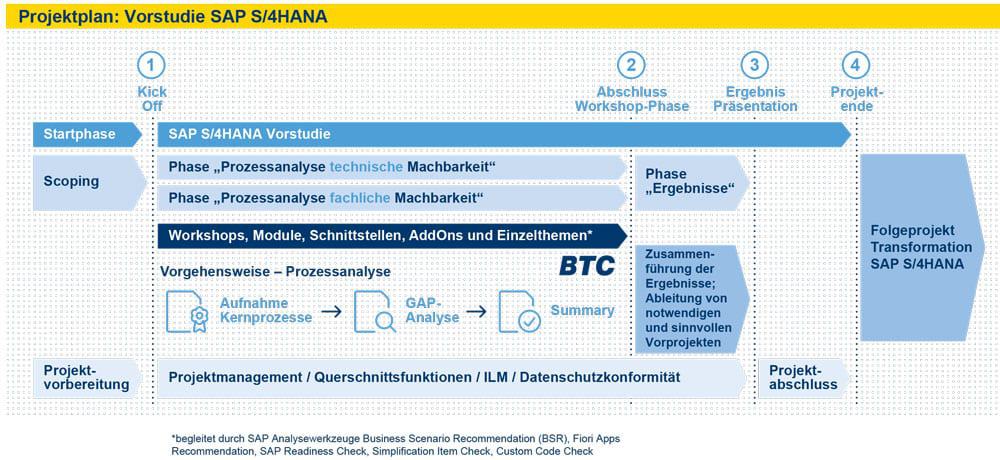Preliminary study creates transparency
![[shutterstock: 593389664, bluedog studio]](https://e3mag.com/wp-content/uploads/2021/01/shutterstock_593389664.jpg)

Users with SAP software in use can usually quickly answer the question about their future ERP system: The future is S/4HANA! The answer as to the best way to implement S/4HANA is less clear. According to a recent study by DSAG - the German-speaking SAP user group - a third of companies are still looking for the most promising transformation approach for their own organization.
There are basically two methods to choose from for the transition: Those who see S/4HANA as the digital core as an opportunity for a complete realignment of business areas and processes will quickly end up with a greenfield implementation in their considerations (greenfield type). On the other hand, those who want to maintain a stable system and process landscape will take the path of a technical system conversion with manageable, step-by-step modifications (brownfield type).
Sometimes both approaches are combined as a selective data transition (bluefield or orangefield type), for example, if a system or process consolidation is being tackled at the same time as part of a technical migration. Or "green-field" processes are selectively merged with a selection of legacy data, processes and in-house developments or add-ons.
From a "helicopter" perspective, the question of whether the introduction of the new ERP generation will be treated primarily as a business project or as an IT project resonates with the choice of transformation approach. In other words, to what extent should the migration to S/4HANA already contribute to the digitization of the company? Or rather: How much effort is required to harmonize the implemented processes with the new SAP world?
The individually grown process and system landscapes in companies as well as the industry specifics mean that the choice of migration path must be made individually. In most companies, there is already a certain rough idea - i.e., a gut feeling - about the appropriate transformation approach and effort.
However, given the importance and scope of the SAP software transition, no one should have to rely solely on their gut feeling. It is therefore advisable to make this decision on the basis of a clearly derivable, objective analysis result. To identify the appropriate transformation approach for a company's organization and thus reduce the solution space for calculating a detailed business case, BTC applies a scoring model.
As part of a multi-stage preliminary study, the installed system landscape, existing business processes, customer needs and the company's own risk appetite are systematically recorded and analyzed. The core is formed by a matrix that records the technical and process-related fundamentals of the company and weights them in terms of their relevance using a scoring model. The resulting scores are condensed into a fact-based transformation profile. On this basis, a precise business case can be developed for the planned S/4HANA transformation.
It goes without saying that careful planning in advance protects against many a nasty surprise and is the key to project success. Before kicking off the actual preliminary study of the S/4HANA implementation, it is therefore additionally advisable to gain clarity about the fundamental aspects of the migration.
In short: The classic W-questions - who, what, why, how, when - must be answered, which (should) form the framework of every project plan. This means that, in addition to this initial objective, an impression should also be gained of what tasks will be involved and what changes will affect one's own organization. The following steps make up the preliminary project:

Inventory and preliminary work
After clarifying the basic orientation, the actual analysis is prepared, the detailed inventory. The existing system and process landscape is checked for its S/4HANA "readiness". In this phase, for example, it is checked whether the existing SAP ERP system is already working with an S/4HANA-compatible release level and supports the Unicode character set. Initial key data regarding the configuration of the target system landscape (server, databases or cloud) is also defined.
At the same time, a lot of attention is paid to application-related issues. We start with comparatively simple tasks, such as checking whether individual customer developments can still run under the new ERP system. It is also helpful to validate the quality of the master data and, if necessary, to clean it up. With a view to migration, this helps to streamline the effort for the upcoming data transfer and save system resources at the same time. It is also essential to check whether the process and object structures set up in the current ERP system are actually reflected in S4/HANA.
New objects such as the central business partner with mandatory customer/vendor integration (CVI) or the central general ledger suggest that previous financial and logistics structures should also be questioned. The same applies to totals and index tables, which are no longer required as a result of HANA in-memory technology and - if necessary - will survive the change as "views".
The accounting nature of the inventory may seem a bit onerous. However, it is fundamental for comparing an organization's evolved system and process landscape with the functional scope of S/4HANA. Fortunately, SAP provides a number of tools that analyze and evaluate the S/4HANA "capability" of an environment at different levels in a way that saves effort.
The Simplification Items Check tool, for example, lists the objects in a system environment that are not available in the new software generation or are only available in modified form. The Custom Code Check determines which individually developed add-ons or modifications are suitable for S/4HANA. And the Transaction Usage report provides information on the tasks for which Fiori apps should be made available to users.
The tools bundled under the umbrella of the S/4HANA checks primarily address technically oriented questions. The BSR Report (Business Scenario Recommendations), on the other hand, deals with process-related aspects, as they are usually requested by employees in the specialist departments. For example, the tool collects typical performance data (KPIs) for business tasks in the existing landscape: "Creation of an order transaction" or "Payment targets", for example. These are then compared with the optimization options of the best practices in the new system (including a benchmark for the industry).
This means that all the necessary information is available for the analysis phase. In a joint workshop, the employees from the business departments and the SAP experts from IT operations can now subject each important process to a fit and gap analysis and illustrate significant changes, especially improvements brought about by the new ERP generation.
For each process, the relevance and the degree of deviation from the standard are recorded in order to determine the necessary scope of change in detail. Finally, the project team brings together the findings for business-critical processes, status quo, change, and benefit through SAP S/4HANA at an aggregated level.
In the subsequent evaluation phase, the technical and process-related fundamentals identified in the analysis are evaluated and weighted according to their relevance and the effort required for the company. The focus here is on the decision-making process for a greenfield or brownfield approach. All results of the analyzed topics are directly incorporated into the scoring model to actively support the decision on the final transformation approach.
The scores determined in the scoring matrix result in a decision pattern at different levels - differentiated by system landscape, business processes, interfaces, master and transaction data, add-ons/modifications. The result of the preliminary study is a comprehensible transformation profile for the respective company - precisely prioritized and weighted according to greenfield or brownfield type.
The result of the workshop - i.e., the transformation profile derived from the real needs - forms a first-class basis for concretizing the notified SAP S/4HANA transformation project. Companies are thus enabled to coherently present a business plan based on facts, including all opportunities and risks. Before the associated implementation plan is drawn up, the scoping, the opportunity should be taken to think through the transformation project once again.
This also includes answering the question of how courageous one's own organization currently is or can be in questioning and changing the established. With the knowledge gained from the preliminary study, it is quite possible - contrary to the original objective - to shift the emphasis on a case-by-case basis. This is what determines whether the greenfield or brownfield approach is recommended or, in other words, whether a business project or an IT project should be implemented.






